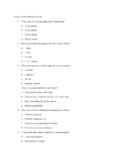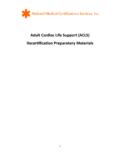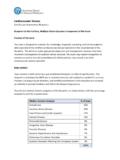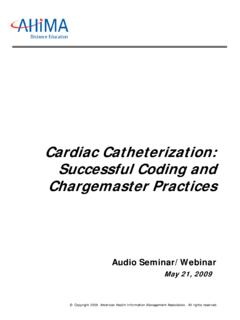Transcription of Modified Bruce Protocol: Treadmill Testing for Cardiac Health
1 Modified Bruce protocol : Treadmill Testing for Cardiac Health Purpose The purpose of this investigation was three-fold: 1) for Dr. Carman to be come acquainted with the Hewlett-Packard 4755 AU Page Writer II EKG instrument in preparation to using it in class, 2) to obtain a Treadmill test for teaching purposes for the second semester of Human Anatomy and Physiology and 3) to obtain a Treadmill test for Dr. Carman's baseline Health studies. Materials Standard EKG materials were readily available. Red Dot (3M) diaphoretic monitoring electrodes with soft cloth tape and solid gel were used (Figure, Below).
2 The EKG Instrument was donated to WNCC by Carson-Tahoe Hospital at the request of Haley Magney (one of Dr. Carman's former students). The technician was Dr. Carman's 9 year-old son, Tyler (Figure, Right). The Treadmill is a PreCOR M Treadmill that is adjustable for speed and elevation (maximum = 15%; Figure, Top Right). Facilities were at Dr. Carman's home. Room temperature was constant at 68 F (20 C). Subject Dr. Carman is a 43 year old male in excellent Health . He is about 5'10" tall and weighs 183 lbs. He is asymptomatic for chest pain, shortness of breath (SOB) or other Cardiac symptomatology.
3 His family history is positive for cardiovascular disease (primarily vasospastic) and cerebrovascular accidents. He does possess earlobe creases. He works out fairly regularly on the Treadmill , lifts weights and hikes and bikes whenever possible. His last blood pressure was taken radially (electronically) at his dentist's (Andrew G. Getas, , 883-8811) office, 01/08/2001, and measured 127/85 with a pulse of 76. The high BP is probably explained by having had only 40 minutes of sleep in that 48 hour period. He fasted overnight for a total of 17 hours prior to completing the exam.
4 The electrodes were placed in standard positions to optimize electrical conductance and minimize electrical noise (Figures, Below). The skin was prepared with isopropyl alcohol and briefly "sanded" with the attached sand spots on the electrodes (Figure, Below). EKG's were obtained at the 3-4 minute time intervals (as opposed to the standard 3 minute intervals in the Bruce protocol ) as the EKG instrument took 1 minute to obtain the 12-lead EKG. The elevation and speed were then adjusted. Methods The Modified Bruce protocol was utilized with the following modifications: Stage 0 was added as a warm-up at 0% and mph, per Berman [1].
5 Stages 4 and 5 had to be Modified as follows: Stage 4 ran with 15% elevation instead of 16% as did Stage 5 rather than 18% due to the limitations of the Treadmill . Blood pressures were not obtained. Pre- Treadmill Electrode Orientation Peri-Treadmilling Post- Treadmill Results Pre- Treadmill The pre-stress test EKG was within normal limits (WNL): EKG Axis performed by the triaxial method (as opposed to the hexaxial method; Figure, Left) is in the range of +80, , WNL. The table, below, summarizes and compares Dr.
6 Carman's interval analysis with normal ranges: Normal Ranges Dr. Carman's Values PR interval: 120-200 msec 200 msec QRS duration: 60-100 msec 60 msec QT interval: 340-420 msec 300 msec QT interval at 40% of R-R time: varies with rate 320 msec Peri- Treadmill Dr. Carman oxidized approximately 300 kcal during this test. He walked miles and went for the duration of the exercise, , 24 minutes, without difficulty. Stage 0: there were no obvious abnormalities identified in this EKG: Stage I: there were no obvious abnormalities identified in this EKG: Stage II: there were no obvious abnormalities identified in this EKG: Stage III: one abnormality was noted in this EKG.
7 Lead V6 appears to demonstrate what appears to be a minimal amount (< 2 mm) of ST segment depression: Stage IV: ST segment depression, again, of a minimal amount (< 2 mm, again) seems to be demonstrated in leads V3, V5 and V6: Stage V: ST depression of < 2 mm appears to be present, as well, in leads V3, V5 and V6: Post- Treadmill The immediately post- Treadmill EKG demonstrates approximately 1 mm ST segment depression in lead V3: The EKG taken 2 minutes post-stress test demonstrates virtually no ST segment depression: The EKG obtained 5 minutes post- Treadmill demonstrates no ST segment depression: The EKG obtained 10 minutes after the Treadmill experience demonstrates normal sinus rhythm: The only potential abnormality in the EKG obtained 12 minutes post- Treadmill is the slightly elevated pulse rate: The table, below, summarizes the interval analysis 12 minutes post- Treadmill : Normal Ranges Dr.
8 Carman's Values PR interval: 120-200 msec 200 msec QRS duration: 60-100 msec 80 msec QT interval: 340-420 msec 260 msec QT interval at 40% of R-R time: varies with rate 248 msec The pulse rates were obtained per each EKG (and recorded on each EKG) and plotted: The exam was stopped at 24 minutes due to having completed all stages of the test. No symptomatology consistent with any other reason to stop the stress test was observed or felt. Discussion Remember from lecture that the various leads from an EKG tell you something about specific parts of the heart, table, below: II, III, aVF examine the inferior portion of the heart.
9 V1 and V2 examine the septum. V3, V4, V5, V6 look at the anterior and lateral aspects of the heart. I and aVL look at the superior/anterior and lateral aspects of the heart. aVR examines the cavity of the heart and is, for all intents and purposes, of almost no value. Remember, also, that specific coronary arteries feed specific regions of the heart. Given the fairly consistent demonstrations of minimal ST segment depression in the lateral leads, it would appear that the "incident" causing the depression is in or around the area of the circumflex artery. Whether the "incident" is partial occlusion, vasospasm or artifact is, of course, unclear.
10 ST segment depression less than 2 mm in depth is considered to be "equivocal" results [2]. With no symptomatology to go along with it, it is probably of minimal significance. ST segment depression greater than 3 mm is considered a positive stress test and further Testing would be performed. Whatever the incident is, it seems to be a temporary, reversible, event. The ST segment depression, however, may also serve as a "wake up call". Dietary strategies may be undertaken and blood tests may be performed, , lipid profiles to look at blood LDL, HDL, total cholesterol levels, ad nauseum, to determine how out of whack they are -- or not.










